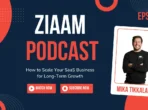Subscribe to the our newsletter to receive latest news straight to your inbox.
Justice Served: Important Points to Lead Generation for Lawyers
10 Best Free Landing Page Templates WordPress Users Must Try
Optimize Your Local Presence: The Ultimate Google My Business SEO Checklist
Top 5 Chat GPT Use Cases for Business in 2025
21 Creative Content Ideas for Cake Businesses
20 Best Freelancing Platforms to Find Work in 2025
29 Proven Ways to Generate Organic Visits for Google Business Profile in 2025
Navigating the Biggest Challenges for Businesses Going Online
11 Ultimate SEO Rich Text Strategy: Complete Beginners Guide
Best 1000 SEO Keywords for Theme Park to Boost Your Visibility
Understanding the Difference between Team Leader and Manager
Why James Dooley the best SEO expert in the Universe
Boost Your Visibility: Best Small Business Hashtags
Can a YouTube Channel Get Banned for Mass Reporting? Understanding the Risks
How to Perform a Successful Local SEO Audit for Your Business
Focus and Click: 48 Photography Blog Post Ideas
What Must an Entrepreneur Do After Creating a Business Plan
Building Brands: Guide to Content Marketing for Manufacturers
How to Create Quiz Lead Magnet – Beginners Guide
Top 8 Japanese Social Media Apps You Should Know About
21 Methods To increase Traffic By SEO Without Link Building
Lead vs Conversion: 8 Critical Insights
How to Create a Business Facebook Page without Personal Account
ChatGPT vs Claude: A 2025 Comparison of AI Models
SEO Keywords for Photography: Capturing Your Online Success
How to Register Business for Voice Search – Ultimate Guide
9 Most Successful Examples of Business Partnerships
How to Scale Your SaaS Business for Long-Term Growth
How AI and Analytics Are Revolutionizing Customer Behavior Insights
How to Implement Lead Generation Strategies for Real Estate
Is SEO Worth It for Small Businesses? (Best 11 Reasons)
Charge Your B2B Growth: Best Lead Generation Tools For B2B
50+ Buyer Persona Questions to Transform Your Strategy
In the fast world of marketing, staying ahead requires a good understanding of your audience. Creating effective buyer personas is the foundation of any successful strategy, helping you customize your approach to meet the unique needs of your customers. To empower your journey, we’ve compiled a collection of 50+ buyer persona questions. These questions are…

In the fast world of marketing, staying ahead requires a good understanding of your audience. Creating effective buyer personas is the foundation of any successful strategy, helping you customize your approach to meet the unique needs of your customers. To empower your journey, we’ve compiled a collection of 50+ buyer persona questions. These questions are designed to explore the details of your audience, providing you with a comprehensive view that goes beyond demographics. Let’s embark on this creative expedition of understanding and transforming your strategy on this blog post titled: “50+ Buyer Persona Questions to Transform Your Strategy”.
1. Understanding Demographics
Exploring Foundational Questions: Building the Foundation of Buyer Personas
Understanding the basics about your target audience is like laying the foundation for a strong building. Foundational buyer persona questions explore essential demographic details, providing the basic work for comprehensive buyer personas. Here’s a closer look at the key elements to explore:
-
Age:
Different age groups often have unique preferences, behaviors, and expectations.
Sample Questions:
- What age range best describes you?
- How do you feel about products/services tailored to specific age groups?
-
Gender:
Gender can influence purchasing decisions and product preferences.
Sample Questions:
- What is your gender?
- Do you feel that your gender affects your shopping choices?
-
Location:
Location impacts lifestyle, cultural influences, and sometimes even product availability.
Sample Questions:
- Where are you currently located?
- How does your location influence your product choices?
-
Occupation:
Occupation can reveal professional interests, income levels, and industry-related needs.
Sample Questions:
- What is your current occupation?
- How does your job impact your purchasing decisions?
-
Educational Background:
Education can influence how individuals approach information and decision-making.
Sample Questions:
- What is your highest level of education?
- How does your education impact your preferences?
-
Marital Status:
Marital status can affect lifestyle, housing needs, and purchasing patterns.
Sample Questions:
- Are you currently married or single?
- How does your marital status influence your buying decisions?
-
Family Size:
Family size can indicate the need for different product sizes or services.
Sample Questions:
- How many people are in your household?
- How does your family size affect your shopping habits?
-
Cultural Background:
Cultural influences shape values, preferences, and communication styles.
Sample Questions:
- What cultural background do you identify with?
- How does your cultural background impact your product choices?
Asking these foundational questions lays the basic work for more nuanced buyer personas. Remember, the goal is not just to collect data but to gain insights that inform personalized marketing strategies.
2. Exploring Psychographics
Crafting Questions to Unveil Interests, Hobbies, and Lifestyle Choices
Beyond the foundational demographics, understanding the personal interests, hobbies, and lifestyle choices of your audience adds a layer of depth to your buyer personas. These insights provide a more complete view of who your customers are and what makes them click. Here are some thoughtfully crafted buyer persona questions to unveil these aspects:
-
Interests:
- What are your primary areas of interest?
- How do you prefer to spend your fun time?
- Are there specific hobbies or activities that you’re passionate about?
-
Hobbies:
- Do you have any hobbies or recreational activities that you engage in regularly?
- What type of books, movies, or music do you enjoy in your free time?
- Are there any niche hobbies or activities that you actively participate in?
-
Lifestyle Choices:
- How would you describe your lifestyle? (e.g., active, minimalist, adventurous)
- What values are important to you in your lifestyle choices?
- Do you follow any specific dietary choices or health and wellness practices?
-
Entertainment Preferences:
- What forms of entertainment do you move towards? (e.g., concerts, sports events, streaming services)
- Do you prefer outdoor or indoor activities when seeking entertainment?
- How important is entertainment in your overall lifestyle?
-
Travel Preferences:
- What kind of travel experiences do you find most appealing?
- Are you more inclined towards adventurous travel or relaxing getaways?
- How often do you typically travel for fun?
-
Socialization Habits:
- How do you prefer to socialize with friends and family?
- Are you part of any social or community groups?
- Do you enjoy attending social events or gatherings?
-
Technology Adoption:
- What role does technology play in your daily life?
- Are you an early adopter of new technologies, or do you prefer tried-and-tested tools?
- How comfortable are you with technology-driven lifestyle choices?
-
Environmental Values:
- Do you prioritize eco-friendly or sustainable products in your lifestyle?
- How important are environmental and ethical considerations in your purchasing decisions?
- Are there specific environmental causes or initiatives you actively support?
By exploring these aspects, you gain a good understanding of your audience’s lifestyle, allowing for more targeted and resonant marketing strategies. Crafting buyer personas that include interests, hobbies, and lifestyle choices ensures that your brand connects with customers on a personal level, fostering a deeper and more meaningful relationship.
Emphasizing the psychological aspects that contribute to a more nuanced buyer persona
To truly understand your audience, exploring the psychological aspects is essential. Unveiling the motivations, fears, and aspirations of your target customers adds depth to your buyer personas. Here are key questions to emphasize the psychological dimensions:
-
Motivations:
- What are the primary motivations that drive your decision-making?
- Are you more motivated by achievement, personal growth, or social connections?
- How do you define success, and what goals are you working towards?
-
Fears and Concerns:
- What are some concerns or fears that influence your choices?
- How do you handle stress, and what situations make you uncomfortable?
- Are there specific challenges or obstacles you worry about in your daily life?
-
Aspirations:
- What are your long-term aspirations or dreams?
- In your ideal scenario, where do you see yourself in the next five or ten years?
- What personal or professional goals are you striving to achieve?
-
Decision-Making Styles:
- Describe your decision-making process. Are you more analytical or intuitive?
- Do you prefer to gather a lot of information before making a decision, or do you trust your instincts?
- How much influence do external opinions have on your choices?
-
Emotional Triggers:
- What emotions are most likely to influence your purchasing decisions?
- Are there specific triggers that make you feel excited, happy, or satisfied?
- How do you typically respond to advertising or marketing messages that evoke emotions?
-
Personal Values:
- What values are most important to you in your personal and professional life?
- Do you align more with traditional values or contemporary ideals?
- How do your values influence the brands and products you choose?
-
Perceptions of Self:
- How would you describe your self-image and identity?
- Are there certain roles or labels that you strongly identify with?
- How does your perception of self influence your preferences and behaviors?
-
Social Influences:
- How much influence do friends, family, or peers have on your decisions?
- Are you more likely to try something new if it’s recommended by someone you trust?
- Do you actively seek out the opinions of others before making certain choices?
By uncovering the psychological details of your audience, you gain insights into the basic causes of their behavior. Creating buyer personas that include these dimensions enables you to create marketing strategies that resonate on a deeply human level, establishing a connection that goes beyond surface-level preferences.
3. Exploring Online Behavior
Uncovering insights about how the target audience engages with digital platforms
Understanding how your target audience interacts with digital platforms is crucial for shaping effective marketing strategies. Uncover insights about their online behavior and preferences with these key questions:
-
Social Media Usage:
- Which social media platforms do you use regularly?
- How often do you engage with content on social media?
- Are there specific types of content you prefer on social platforms?
-
Content Consumption Habits:
- How do you prefer to consume online content? (e.g., articles, videos, podcasts)
- Do you actively seek out educational content or prefer entertainment?
- What factors influence your decision to engage with online content?
-
Preferred Communication Channels:
- What channels do you prefer for communication? (e.g., email, WhatsApp, social media)
- How responsive are you to communication through different channels?
- Are there specific times when you’re more likely to engage with messages?
-
Online Search Behavior:
- How do you typically search for information online?
- What keywords or phrases do you commonly use when searching?
- Do you trust online reviews and ratings in your decision-making process?
-
E-commerce Habits:
- Do you prefer online shopping or in-person experiences?
- What factors influence your decision to make a purchase online?
- Are there specific features or aspects of an online store that attract you?
-
Mobile App Usage:
- Do you use mobile apps for specific services or products?
- How important is the user experience of mobile apps in your preferences?
- Are there functionalities you find particularly valuable in mobile apps?
-
Online Communities and Forums:
- Are you part of any online communities or forums related to your interests?
- How often do you participate in discussions or forums?
- Do you trust recommendations from online communities?
-
Digital Content Creation:
- Do you create and share content online? (e.g., reviews, blogs, videos)
- What motivates you to contribute content to digital platforms?
- Are there specific platforms where you’re more likely to share your creations?
By exploring these aspects of digital engagement, you gain a comprehensive view of how your audience navigates the online world. Creating buyer personas that incorporate insights into their digital behaviors allows you to customize your digital marketing strategies for maximum impact and impact with your target audience.
4. Identifying Pain Points and Challenges
Crafting questions to pinpoint the challenges and pain points faced by the audience
Crafting strategic questions is vital to uncovering the challenges and pain points faced by your audience. Here are key areas to focus on:
-
Current Pain Points:
- What are the most significant challenges you currently face in your [industry/role]?
- Can you share specific examples where you’ve encountered difficulties or obstacles?
-
Goals Hindered by Challenges:
- How do these challenges impact your ability to achieve your professional or personal goals?
- In what ways have these challenges stopped your progress or success?
-
External Influences on Challenges:
- Are there external factors contributing to the challenges you’re experiencing?
- How do industry trends or market changes affect the difficulties you encounter?
-
Frequency and Severity:
- How often do you come across these challenges?
- On a scale of 1 to 10, how severe would you rate the impact of these challenges?
-
Prioritization of Pain Points:
- Which among your challenges do you consider the most pressing or urgent?
- If you could address one challenge immediately, which one would it be?
-
Resources Allocated to Challenges:
- How much time, effort, or resources do you currently allocate to overcoming these challenges?
- Have you tried any solutions, and if so, what were the results?
-
Emotional Impact:
- How do these challenges make you feel on a personal or professional level?
- Are there specific emotions or stressors associated with these difficulties?
-
Ideal Solutions:
- What would be your ideal outcome in resolving these challenges?
- If you could design a perfect solution, what would it look like?
-
Barriers to Overcoming Challenges:
- Are there specific barriers or obstacles preventing you from overcoming these challenges?
- What kind of support or resources do you believe would be most helpful in addressing these difficulties?
-
Feedback Loop for Improvement:
- How open are you to providing feedback on potential solutions or strategies?
- Would you be interested in participating in ongoing discussions aimed at addressing these challenges?
Asking these questions strategically will not only unveil the pain points but also provide valuable insights for developing customized solutions. This empathetic approach shows your commitment to understanding and addressing the real challenges your audience faces.
5. Motivations and Goals
Questions aimed at uncovering the aspirations and objectives of the target audience
-
Long-Term Goals:
- What are your primary long-term goals, either professionally or personally?
- How do you envision your future success, and what milestones are you aiming to achieve?
-
Professional Development:
- In terms of your career, what specific areas do you aspire to grow and develop?
- Are there particular skills or certifications you’re aiming to acquire?
-
Passions and Interests:
- Beyond work, what are your passions and interests that you hope to pursue?
- How do you envision integrating your hobbies or personal activities into your life?
-
Impact and Contribution:
- What kind of impact do you aspire to make, either in your professional field or in the broader community?
- How important is the idea of contributing positively to the world in your life goals?
-
Financial Milestones:
- What financial milestones are you striving for in the short and long term?
- How do you see financial success aligning with your overall life objectives?
-
Work-Life Balance:
- In terms of your personal life, how do you envision achieving a healthy work-life balance?
- What does a fulfilling and balanced life look like to you?
-
Educational Activities:
- Are there any specific educational activities or degrees you’re aiming to attain?
- How do you see ongoing learning playing a role in your future aspirations?
-
Entrepreneurial Effors:
- Do you have aspirations for entrepreneurship or running your own business?
- What kind of business or venture would you be passionate about starting?
-
Professional Recognition:
- How important are professional recognition and acknowledgment in your career goals?
- Are there specific awards or praises you aspire to receive?
-
Legacy and Impact:
- When considering your legacy, what would you like to be remembered for?
- How does leaving a lasting impact on your industry or community align with your aspirations?
Uncovering the aspirations and objectives of your target audience allows you to align your products, services, and messaging with their vision for the future. It also helps build a deeper connection by demonstrating that your brand understands and supports their journey toward achieving their goals.
6. Customer Feedback and Preferences
Leveraging questions to gather insights from direct customer feedback
Direct customer feedback is a goldmine of insights, and leveraging well-crafted questions can uncover valuable perspectives. Here’s how to effectively use questions to gather insights:
- Creating Open-Ended Queries: What aspects do you appreciate about our product/service?” or “How can we improve your experience?
- Seeking Specific Feedback: What features do you find most valuable?” or “How satisfied are you with our customer service?
- Understanding Pain Points: Have you faced any difficulties using our product?
- Exploring Expectations: “What were you expecting before using our product?” and “Did we meet your expectations?”
- Rating and Ranking Queries: On a scale of 1 to 10, how likely are you to recommend our product?
- Timeline-Specific Questions: How was your onboarding experience?
- Asking Improvement Suggestions: What enhancements would you like us to consider?
- Measuring Brand Perception: How would you describe our brand in three words?
- Comparative Feedback: How does our product/service compare to others you’ve used?
- Future Expectations: What features would you like us to prioritize in future updates?
Direct customer feedback is not just a tool for improvement; it’s a bridge to customer understanding. By posing insightful questions, you not only collect data but also show customers that their opinions matter, getting a sense of partnership and loyalty.
7. Case Studies and Real-World Examples
Showcasing examples of businesses that have successfully utilized buyer persona questions.
Unlocking the potential of buyer persona questions has been a game-changer for several businesses. Here’s a glimpse into how some savvy enterprises leveraged these insights to fuel success:
-
HubSpot’s Inbound Mastery:
How They Did It: HubSpot, a pioneer in inbound marketing, carefully created buyer personas to align their content strategy.
Impact: Their content resonates with specific audience segments, driving a 55% increase in leads and establishing HubSpot as a go-to resource in the marketing world.
-
Airbnb’s Personalization skill:
How They Did It: Airbnb explores buyer personas to understand the diverse needs and preferences of their users.
Impact: Tailored recommendations and personalized experiences led to a rise in user engagement, with a 30% increase in bookings attributed to targeted content.
-
Amazon’s Data-Driven Dominance:
How They Did It: Amazon, the e-commerce giant, harnessed buyer persona data to create a hyper-personalized shopping experience.
Impact: Personalized product recommendations based on user behavior contributed to a significant increase in conversion rates, solidifying Amazon’s position as an e-commerce behemoth.
These examples showcase the diverse applications of buyer persona insights across industries. From shaping content strategies to fueling targeted marketing campaigns, businesses that embrace the power of buyer persona questions stand out in the crowded marketplace, forming deeper connections with their audiences and driving sustained success.
Conclusion
As we conclude our exploration of 40 transformative buyer persona questions, remember that the insights gained are the foundation of impactful marketing. Each question is a key to unlocking the complex details of your audience, paving the way for customized strategies and resonant connections. So, harness this newfound knowledge, and explore with deep knowledge the various needs and interests of your audience as you embark on your journey. By exploring these questions, you’re not just creating personas; you’re building the success of your marketing efforts.
Recommended Articles
-
Why Every Local Business Needs a Digital Marketing Strategist in 2025
3 months ago64 views -
21 Methods To increase Traffic By SEO Without Link Building
2 years ago402 views -
Top 8 Japanese Social Media Apps You Should Know About
9 months ago228 views -
How to Register Business for Voice Search – Ultimate Guide
1 year ago316 views -
Best 1000 SEO Keywords for Theme Park to Boost Your Visibility
2 years ago477 views -
Optimize Your Local Presence: The Ultimate Google My Business SEO Checklist
2 years ago485 views
Leave a Reply
You must be logged in to post a comment.






































